Valérie Kobi
Natural history and medicine encountered, early in their histories, an interesting paradox: although sciences of the living, they nonetheless relied on the study of inanimate specimens. The proper conservation of anatomical remains, both human and animal, posed an ongoing problem for centuries, meaning that artificial substitutes were often the only option. Their creation was generally entrusted to skilled craftsmen or artists who were charged with imitating nature to the highest degree of illusionism and capturing the form and expression of living specimens. Put at the service of the sciences, the power of art entailed breathing life into dead matter and thereby deceiving, even for a brief moment, the beholder. If the pursuit of artistic liveliness, or vividness, has long been a topic in art history, particularly in the study of sculpture,[1] it has not been sufficiently addressed in the fields of natural history and medicine.[2]
Yet, this artistic phenomenon played an important role in the constitution and demonstration of scientific knowledge, in addition to inciting much debate and material experimentation.[3] Attempts to keep natural specimens in wax or to design biological models in glass constitute only a few examples of these endeavors (Figs. 1 and 2).[4] A desire for vividness also prompted the development of complementary strategies that were meant to influence the spectator’s confrontation with such specimens. Along with borrowing representational conventions and techniques from the fine arts,[5] the visual language of science simultaneously adopted practical and structural elements like display cases, frames, and pedestals in all kinds of materials and forms. These devices functioned not only to protect the objects and facilitate their manipulation but also to isolate them and enhance their visibility.[6] In short, they “define[d] and g[a]ve voice to”[7] the objects they presented, thus contributing to a specimen’s efficacy and effect.
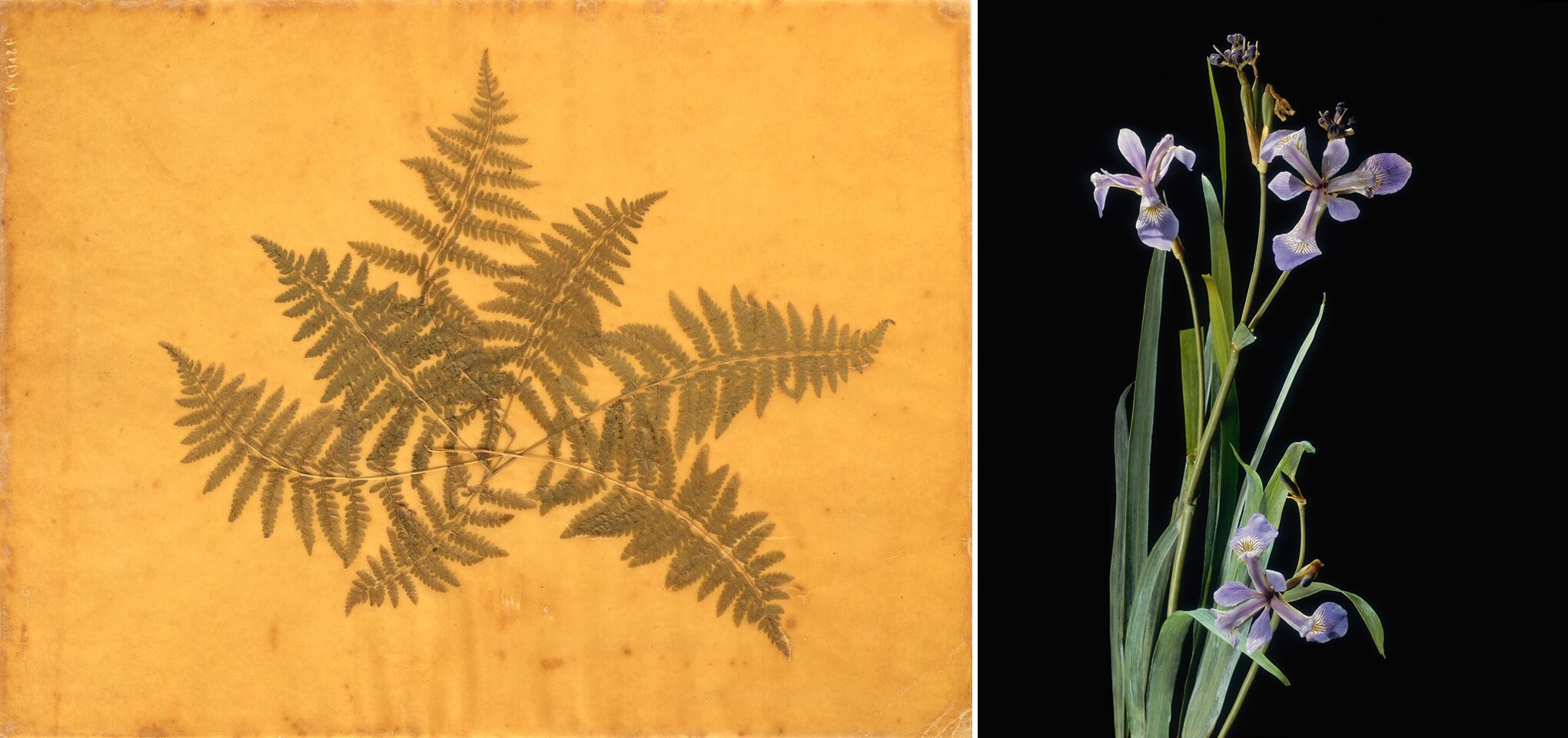
LEFT: Fig. 1. Plant Casts in Wax, c. 1780-1820. Organic materials and wax, 21 x 30 cm. Goethe-Nationalmuseum, Weimar. © Klassik Stiftung Weimar/Walter Oppel.
RIGHT: Fig. 2. Rudolf Blaschka, Iris Versicolor L., 1896. Flameworked Glass, 87 x 60 x 15 cm. Harvard Museum of Natural History, Cambridge, MA. © The Archives of Rudolf and Leopold Blaschka and the Ware Collection of Blaschka Glass Models of Plants, Harvard University, Cambridge, MA.
Specialists who prepared scientific specimens were aware of this potential and frequently employed such staging devices in order to reinforce the realism of their creations. The most common expression of this strategy consisted of setting the specimens in a naturalistic environment—for example, replacing pedestals with branches, whether artificial or not.[8] Commenting on this type of practice in eighteenth-century France, the naturalist Pierre Jean Claude Mauduyt de la Varenne observed that it “increases the illusion” and “spreads the appearance of life.” He continued, however, by warning about the risk of going too far with naturalistic ornamentation, which could break the illusion of reality and underline the falseness of the specimens.[9] But other, more subtle resources were also effectively deployed to blur the distinction between dead and living organisms. The tableau format, used for the presentation of natural history specimens, was one of them. Examining several key examples of natural history tableaux fabricated in Europe during the long eighteenth century, this article will focus on the tableau concept—as both a structural and a visual entity—and will demonstrate how this mode of representation shaped the creation of lifelike specimens situated at the intersection of art history and the history of science.
Natural History Tableaux
The tableau occupied a central place in the ideas and practices of early modern Europe. Building on Michel Foucault’s affirmation that “the center of knowledge in the seventeenth and eighteenth centuries is the tableau,”[10] Annette Graczyk has recently demonstrated the importance of this concept in science, art and literature.[11] Moreover, for eighteenth-century arts and theater, Michael Fried has shown that the notion was far more ambiguous than one might suspect, emphasizing in particular Shaftesbury’s influence on its theorization.[12] In his short essay “Jugement d’Hercule,”[13] published in 1712 and translated one year later into English, the philosopher defined what he termed “Tableau” in French and “Tablature” in English:
[W]e may give to any particular Work the name of Tablature, when the Work is in reality “a Single Piece”, comprehended in one View, and form’d according to one single Intelligence, Meaning, or Design; which constitutes a real Whole, by a mutual and necessary Relation of its Parts, the same as of the Members in a natural Body.[14]
Shaftesbury combines two definitions in his concept of “Tableau/Tablature.” The first consists of the strict meaning of the term, the most common and literal one, which refers to a defined, moveable surface bearing an artistic representation (i.e. a canvas, but not a fresco). It follows in this instance the sense of the word’s Latin root, Tabula, which originally denoted a rigid support—whether in gold, ivory, silver, stone, or wood—specifically prepared to receive an inscription or an image.[15] The second definition expands the notion to one having a broader aesthetic signification, namely a visual structure or representation conceived as an organic whole.
This second definition is of particular interest to us. The principle of the whole articulated here by Shaftesbury is a well-known element of the eighteenth-century concept of painting.[16] The underlying idea maintained that, thanks to its unity, the tableau was offered in a single glance to the beholder, thus becoming immediately intelligible. This instantaneity of the gaze participated in the effect that the painting could make on its viewer. According to Michael Fried, paraphrasing Roger de Piles’ Cours de peinture par principes, “a painting […] had first to attract and then to arrest and finally to enthrall the beholder, that is, a painting had to call to someone, bring him to a halt in front of itself, and hold him there as if spellbound and unable to move.”[17] In his text de Piles developed the thought even further, associating the magnetic force of painting with its ability to entertain and instruct the spectator.[18]
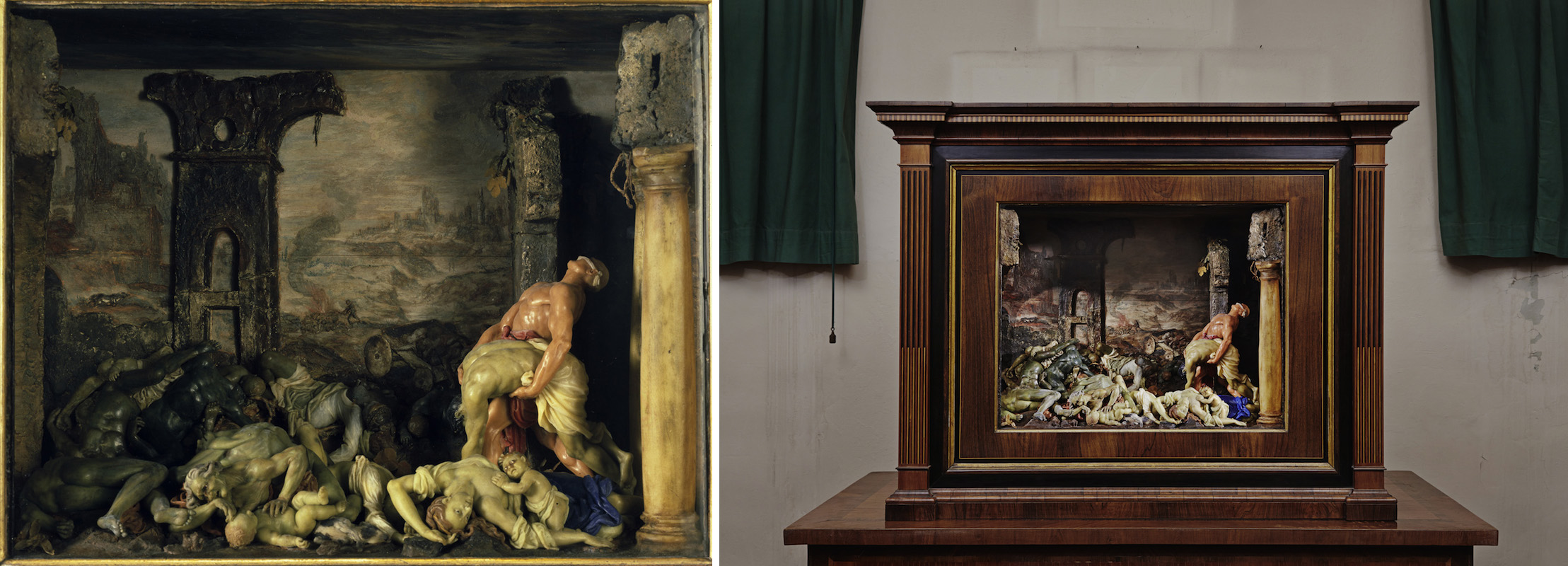
LEFT: Fig. 3. Gaetano Giulio Zumbo, The Plague (detail), 1691-1694. Colored and molded wax relief, approx. 90 x 90 x 45 cm. “La Specola” Museum of Natural History, Florence. © akg-images/Orsi Battaglini.
RIGHT: Fig. 4. Gaetano Giulio Zumbo, The Plague, 1691-1694. Colored and molded wax relief, approx. 90 x 90 x 45 cm. “La Specola” Museum of Natural History, Florence. © Nick Ballon Photography.
A direct legacy of René Descartes’s theory of memory, this assumption of a correlation between the experience of profound impressions and the production of knowledge was a cornerstone of eighteenth-century pedagogy.[19] As Anke Te Heesen has shown, images—and particularly tableaux—played an important role in education as instruments of knowledge.[20] In their Cours complet d’anatomie, Arnaud-Éloi Gautier Dagoty and Nicolas Joseph Jadelot asserted that:
In order to instruct men, one needs to appeal to the attraction of pleasure; but how can one render the image of death agreeable? However, Anatomy asks for more tableaux than arguments; the most learned treatises do not give an exact idea of their objects if nature is not under the eyes of those who study them.[21]
It is therefore not surprising that the form of the tableau flourished in natural history and in other scientific disciplines. Some particularly relevant examples include Gaetano Giulio Zumbo’s colored wax tableaux, such as The Plague (Figs. 3 and 4) kept in the national history museum “La Specola,” which are today recognized as the first instances of anatomical wax modeling;[22] Josef Bonavita Blank’s Musivgemälde, mosaic paintings made of feathers, cobwebs, mosses, and other natural materials, bought in 1803 for the natural history cabinet of Würzburg University;[23] and André Pierre Pinson’s anatomical wax tableaux made for Louis-Philippe II, Duke of Orléans’s private cabinet (Fig. 5).[24] By staging the specimens and presenting them as a whole, the tableaux reinforced their effect. The arrangements were thereby better able to strike the beholder’s imagination and help him or her remember and successfully assimilate scientific lessons. A comparable dynamic appears in the powerful rhetoric employed by natural historians and anatomists, where the vividness of their descriptions were meant to leave a deep impression on their readers.[25] Johann Wolfgang and August von Goethe’s bird collection provides another illustration of this process, one worth addressing in more detail.
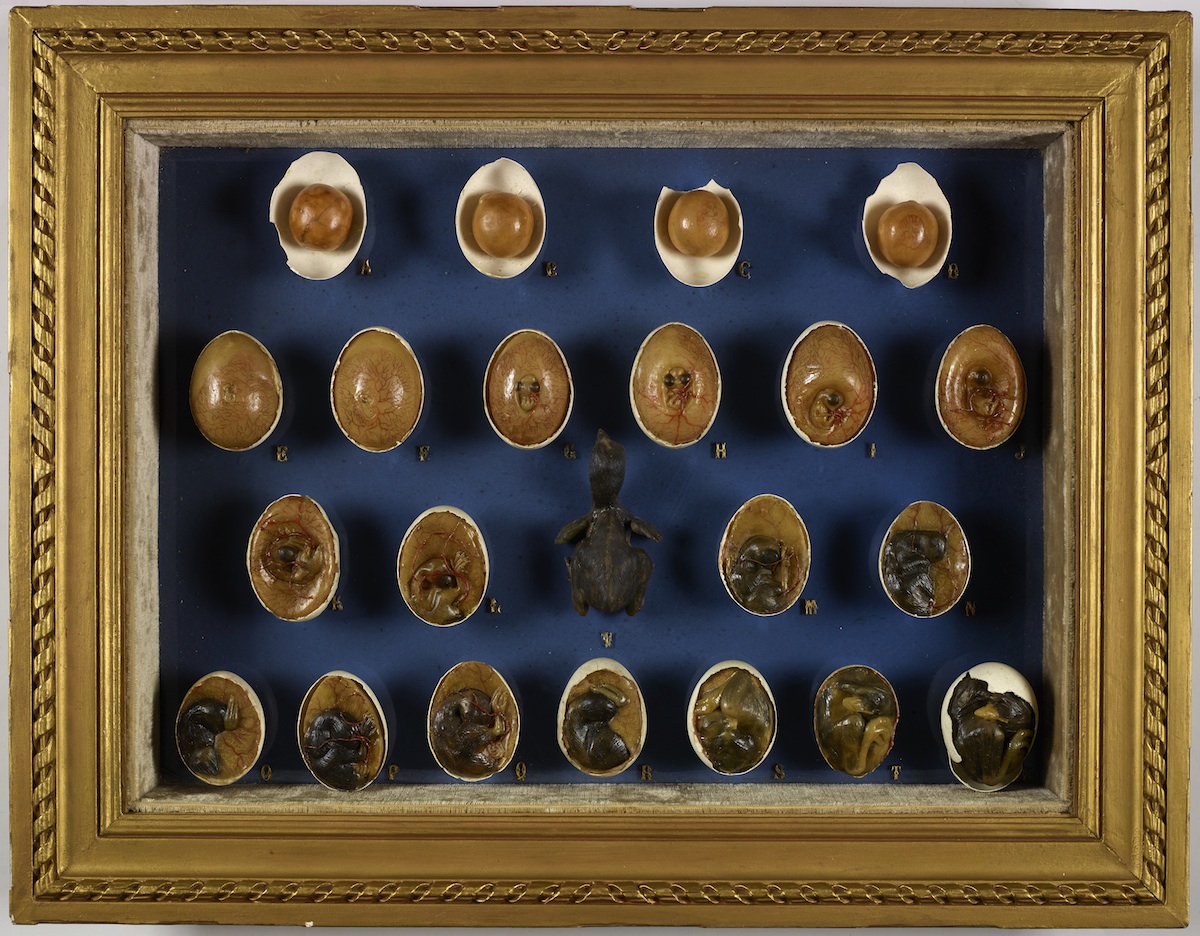
Fig. 5. André Pierre Pinson, Chicken Egg Development, before 1793. Colored and molded wax relief, 42 x 54 x 8 cm. Muséum national d’histoire naturelle, Paris. © Muséum national d’histoire naturelle – Direction des bibliothèques et de la documentation.
Johann Wolfgang and August von Goethe’s Bird Collection
While Johann Wolfgang von Goethe is known mostly for his literary work, ranging from novels to aesthetic criticism to scientific texts, he was also an accomplished collector of prints, drawings, and scientific specimens.[26] In Weimar he assembled a vast natural history cabinet composed of over 23,000 objects.[27] His son August followed the same path and, after his premature death in 1830, both collections were merged to form the ensemble still kept in the Goethe-Nationalmuseum. The birds represent a small part of this assemblage as only twenty-one of them are mentioned in the catalogue made by Johann Christian Schuchardt at the request of Goethe’s heirs.[28] They are mounted in glass-covered boxes with painted backgrounds (Figs. 6 and 7). At the time, it was common for stuffed animals to be kept in sealed cases for conservation reasons.[29] What is unusual, however, is the birds’ display in a pictorial setting.
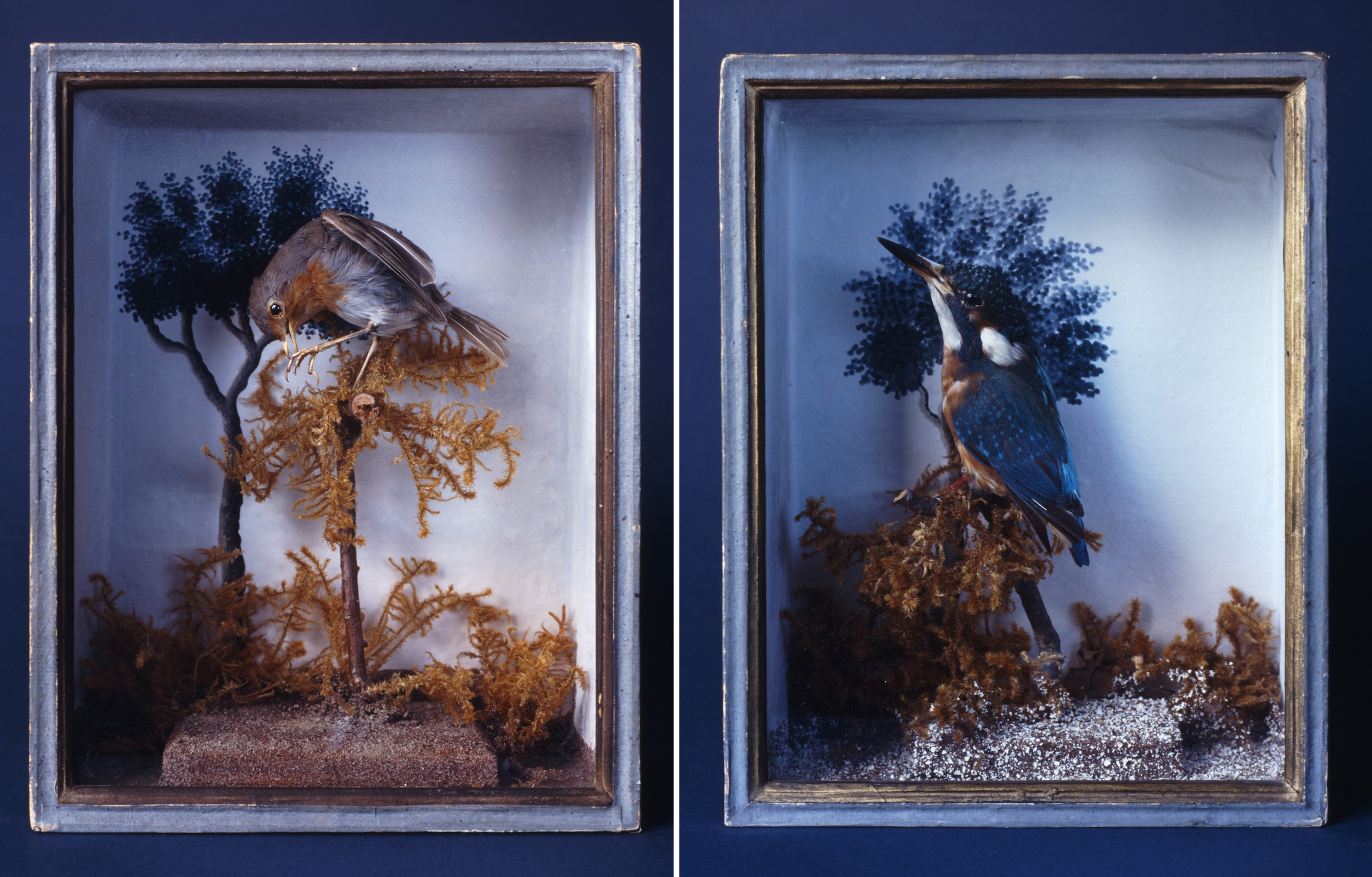
LEFT: Fig. 6. Robin Redbreast, before 1790. Stuffed bird and painted background, 30 x 23 x 12 cm. Goethe-Nationalmuseum, Weimar. © Klassik Stiftung Weimar/Thomas Korn.
RIGHT: Fig. 7. Kingfisher, before 1790. Stuffed bird and painted background, 28 x 22 x 11 cm. Goethe-Nationalmuseum, Weimar. © Klassik Stiftung Weimar/Thomas Korn.
Looking at the kingfisher (Fig. 7), Karen Wonders described it as an early example of a habitat diorama, one that emphasized illusionism through a combination of high-quality taxidermy and naturalistic composition: “[t]he background vegetation […] is rendered in a pointillistic style to emphasize how the colouration pattern of the bird blends into its natural surroundings.”[30] Designating this object as an early diorama is most certainly correct, but the recurring décor for different species of birds goes against the idea of a conscious correlation between bird type and “habitat” (Figs. 6 and 7). Instead the painted backgrounds are uniform, an effect that was probably done for practical and financial reasons but that had the added advantage of contributing to the pedagogical purposes of the collection. While these backgrounds are realistic enough to please the eye and attract the beholder, they are also similar enough to invite the viewer to establish comparisons between the various birds. Furthermore, setting the animals in such an environment facilitates the second step of the learning process: the direct recognition of the species outside the cabinet, in nature.[31]
Among the specialists who participated in the creation of such bird cases was Johann Ehrenfried Schumann, a theater painter active in Weimar at the court of Duke Carl August of Saxe-Weimar-Eisenach. His involvement is representative of the increasing tendency during the eighteenth century to employ painters as practitioners in the field of taxidermy.[32] In 1794, the naturalist Jean-Baptiste de Lamarck, a professor tasked with selecting an aide-naturaliste[33] for the Muséum, chose the painter Jean Baptiste Simon Ferdinand Desmoulins over the soon-to-be-famous anatomist Georges Cuvier, the latter being considered “more savant than artist.”[34] Lamarck’s comment not only draws a clear line between the occupation of the aide-naturaliste and that of the savant, but also indicates the kinds of talents and expertise necessary for fulfilling such a position. Interestingly enough, a similar distinction can be found in taxidermy handbooks of the time, where the importance of the preparator’s artistic abilities are recognized: “One can compare the Artist who is mounting a bird to a Painter making a portrait.”[35] Far from being insignificant, the contribution of painters to taxidermy reveals the type of effects sought and material strategies used in order literally to stage animals within realistic tableaux. The involvement of artists was probably meant to ensure the creative arrangement and “pictorial” composition of specimens and, through these techniques, to guarantee their lifelike illusion.
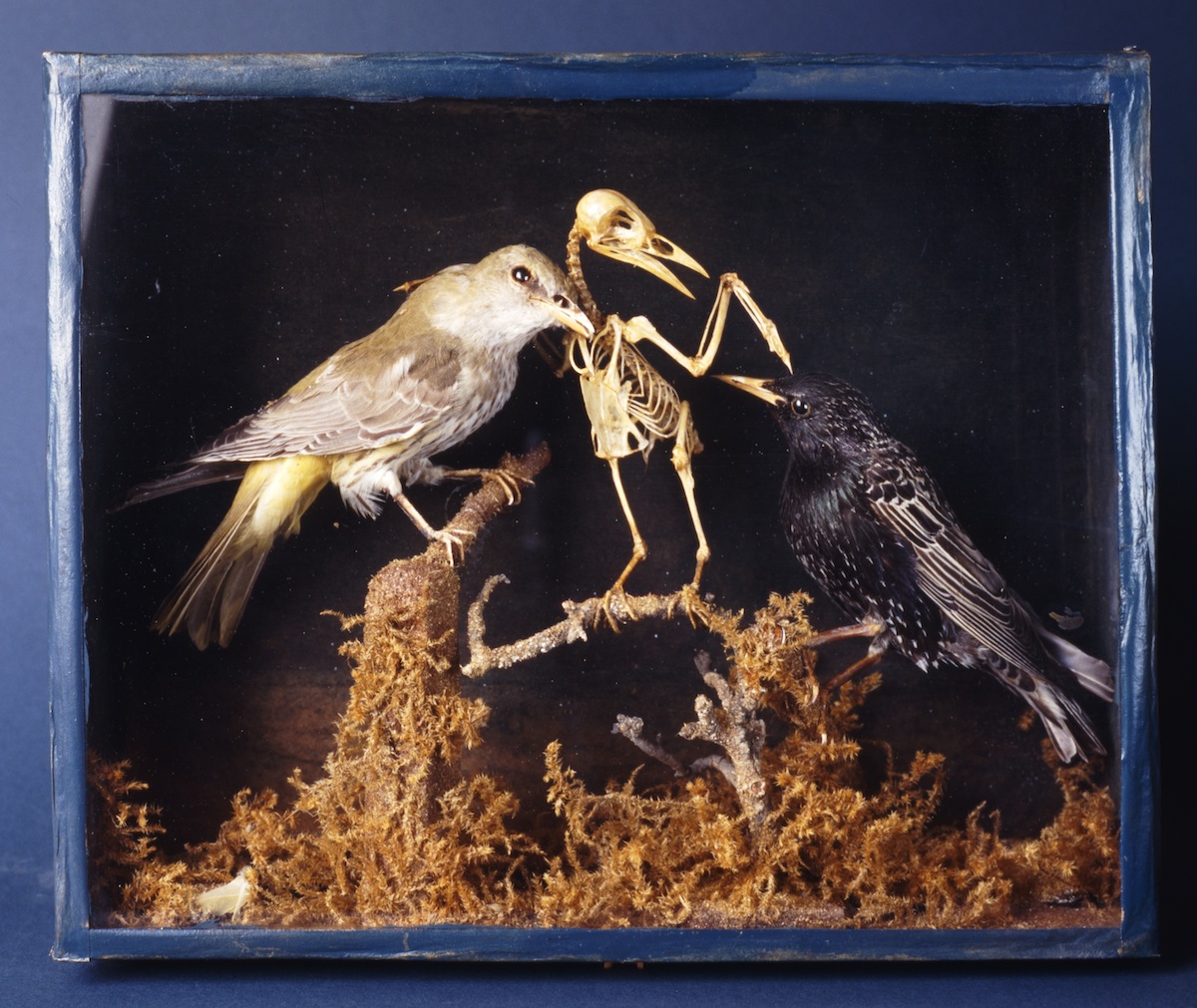
Fig. 8. Starling, Oriole and a Bird’s Skeleton, before 1790. Stuffed birds, skeleton and painted background, 29 x 36 x 6.5 cm. Goethe-Nationalmuseum, Weimar. © Klassik Stiftung Weimar/Thomas Korn.
Although, in the case of the Goethe bird boxes, this illusion may have been limited by the objects’ relative simplicity, their physical staging—from their confined dimensions to their visual unity and frozen-in-motion aspect—nonetheless speak to a propensity to shape their appearance according to pictorial principles. The similarities may, in some cases, go further, as in the example of a box showing stuffed birds and a skeleton side by side (Fig. 8). The juxtaposition allows an immediate comparison between the winged creatures but also recalls the aesthetic tradition of the memento mori, a genre of painting that became extremely popular in seventeenth-century European art. The analogy with painting persists even in the materiality of the objects that—through their framing, tagging and hanging system (Figs. 9 and 10)—suggests an explicit structural connection to the tableau category.[36] Mostly stuck to the backs of the boxes, the labels underline that the specimens were probably meant to be not only looked at but also handled, taken off the wall and turned, in order to learn or confirm the birds’ identities. This pedagogical practice, quite typical of the eighteenth and nineteenth centuries, can be found in a number of other instruments and sites of knowledge at the time, such as the Morgensternsche Miniaturkabinett, a miniature gallery of paintings kept in Frankfurt.[37] Moreover, the Linnaean taxonomy of the animals found on the tags also asserts the scientific aims behind the specimens, which were originally fabricated for the University of Jena before passing into the Goethes’ private collection.
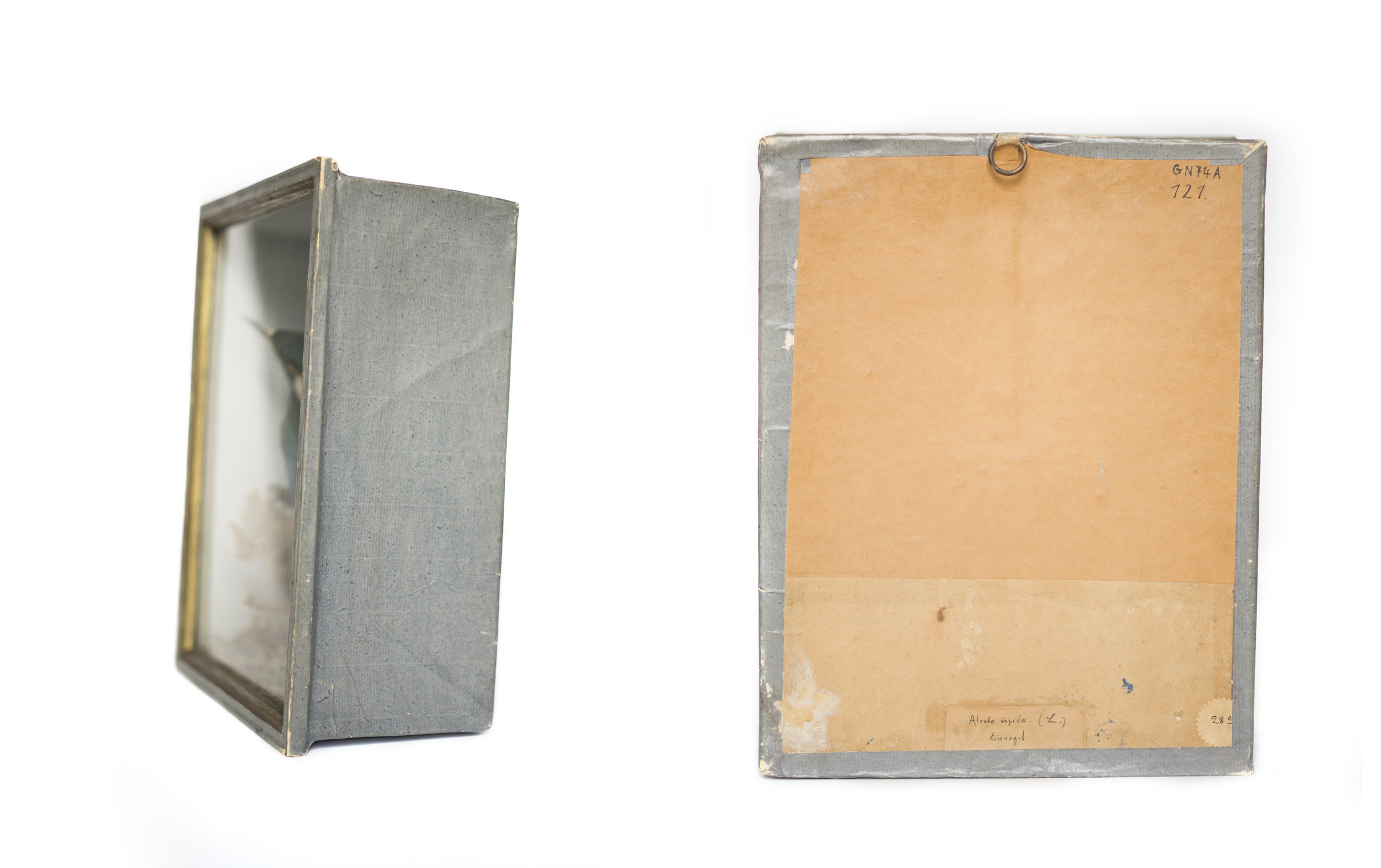
Figs. 9 and 10. Kingfisher (details), before 1790. Stuffed bird and painted background, 28 x 22 x 11 cm. Goethe-Nationalmuseum, Weimar. © Klassik Stiftung Weimar/Walter Oppel.
Indeed, among the numerous administrative functions held by Goethe as Privy Councillor and then State Minister for Duke Carl August was the administration of Jena University. In this context, he actively contributed to the development of the university collections in the fields of natural history and medicine.[38] As complementary tools to university courses, the specimens were thought to encourage a more practical approach to education. The increased emphasis on tactility as a source of knowledge in the second half of the eighteenth century, particularly in treatises like Étienne Bonnot de Condillac’s Traité des sensations and Johann Gottfried von Herder’s Plastik,[39] enhanced the epistemic value attributed to collections, whether scientific or artistic.[40] As seen in his writings, Goethe was also a proponent of hands-on learning. In a letter to his colleague Christian Gottlob von Voigt, he stressed the necessity of keeping the university’s mineral collection in cabinets equipped with drawers (as opposed to glass-fronted cabinets) in order to facilitate the manipulation of the specimens.[41] Also, in his novel Wilhelm Meisters Wanderjahre, Goethe defended the attainment of medical knowledge through the manipulation of anatomical wax and wooden models.[42] Just as Goethe’s protagonist Wilhelm did, the students of the University of Jena experienced the benefits of a collection, one that grew significantly under Goethe’s supervision.
Most of the birds now in the Goethe collection were given in 1802 to his son, the young August von Goethe, by Justus Christian Loder, professor of surgery and anatomy at the University of Jena.[43] Following the model established for the university, the birds, which were initially held in August’s private natural history cabinet, were meant for his education. This practice was common in the period, when children’s collections were found in many households of the aristocracy and the bourgeoisie.[44] This particular function may explain the small amount of bird specimens on hand, the collecting process here being more representative than systematic. The same principle also applies to other objects in the cabinet, including a voluminous herbarium and a collection of small skeletons, among them birds and tetrapod vertebrates (Fig. 11).[45] Just as the memento mori glass case set stuffed and skeletal birds in juxtaposition (Fig. 8), the collection of zoological skeletons invited such comparisons as well, especially since some of the species had their counterparts in stuffed form. The adjacency of stuffed and skeletal specimens was a widespread museological approach—used, among other places, at the University of Jena[46]—that fostered the acquisition of knowledge through the establishment of comparisons. This type of close study encouraged progressive understanding of the facts and laws of nature. The coexistence of the tableaux, which present birds in a lifelike pose and natural surroundings, with the sculptural skeletons slowly leads the beholder both to recognize the appearance of the various types of birds present in the collection and also to learn about their internal structure. In other words, the viewer passes from external naturalistic vision to internal anatomical perception, from a comparative gaze to its analytical counterpart.[47] This visual progression corresponds to a well-known strategy already at work in many scientific and technical publications of the eighteenth century, including Denis Diderot and Jean le Rond D’Alembert’s Encyclopédie as well as Georges-Louis Leclerc de Buffon’s Histoire naturelle.[48]
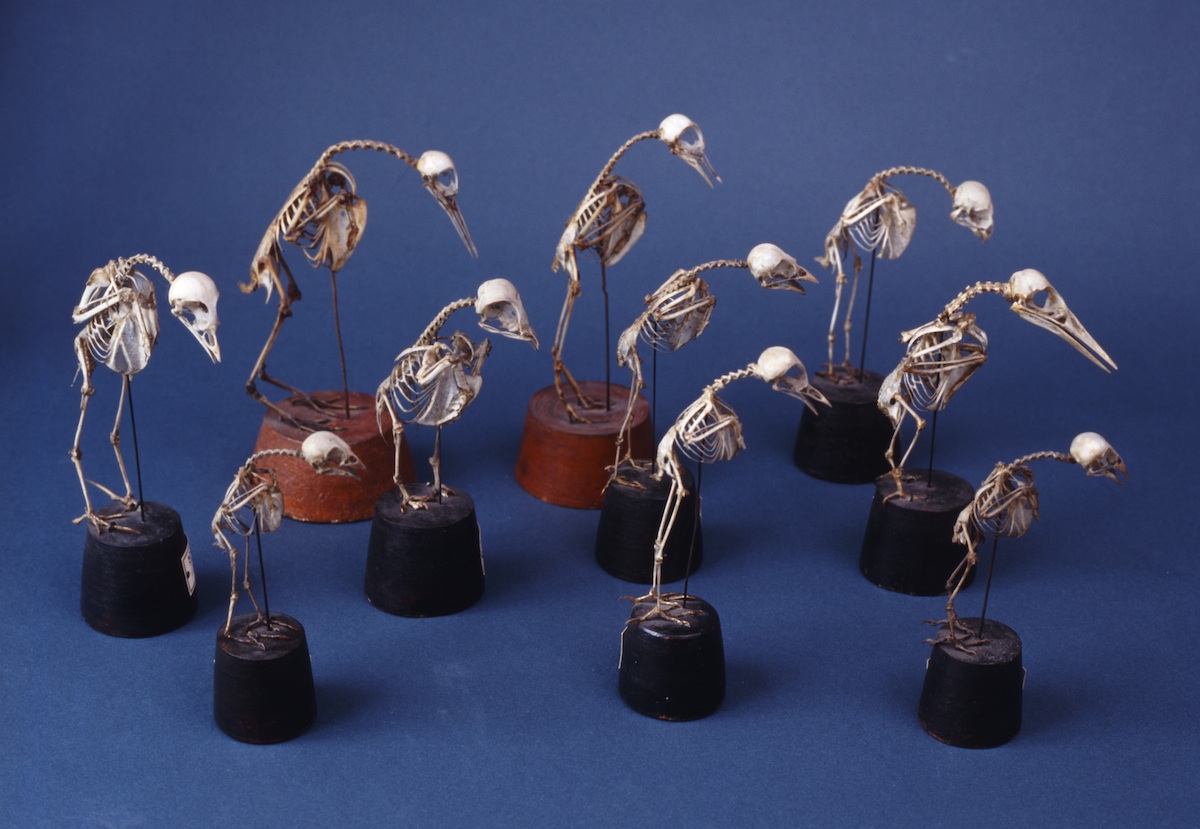
Fig. 11. Bird Skeletons, before 1802. Organic material and wire frame. Goethe-Nationalmuseum, Weimar. © Klassik Stiftung Weimar/Thomas Korn.
In this sense, the birds perfectly illustrate the way knowledge was made, transmitted, and acquired at this moment. They reveal an interest in enhancing the didactic efficacy of such objects by going beyond straightforward presentation in order to attend to their aesthetic dimensions and artistic strategies. Louis-Sébastien Mercier drew attention to the importance of such artifices in his Tableau de Paris:
A lady [Madame de Montreuil] discovered how to conserve them [the birds] but also to animate them; she found the secret to preserving them forever from insects. […] Her genius then gave them life by composing charming idylls in this genre. […] By acquiring this lady’s secret of conservation and by following her pleasant ideas, one could compose animated & diversified tableaux of these bird families.[49]
Anticipating the development of the field from early specimens, like those in Johann Wolfgang and August von Goethe’s collection, to nineteenth-century dioramas, Mercier suggests art’s potential life-giving power and efficacy when used in the service of the sciences. He also reminds us that in order to better understand the creation of lifelike objects and their reception throughout the eighteenth century, one may have to look not only at the materiality and quality of the prepared specimens but also at their presentation. As instruments of education, natural history specimens are consciously staged artifacts that offer insight into the scientific imaginary and practices of the time. Goethe’s bird collection allows us to see both the tableau format as an instrument for shaping the beholder’s experience and, furthermore, the fluid boundary between the arts and sciences in the long eighteenth century.
Valérie Kobi is Postdoctoral Researcher at Bielefeld University, Germany
Acknowledgements: Many thanks to Noémie Étienne, Meredith Martin and the two anonymous reviewers for their insightful comments. I would also like to express my gratitude to Sophia Ronan Rochmes, who carefully read and corrected this article.
[1] See, for example, Caroline van Eck, Art, Agency and Living Presence. From the Animated Image to the Excessive Object (Leiden: Leiden University Press, 2015).
[2] Two exceptions include Georges Didi-Huberman, “Ressemblance mythifiée et ressemblance oubliée chez Vasari: la légende du portrait sur le vif,” Mélanges de l’École française de Rome. Italie et Méditerranée 106:2 (1994), 383-432; and Jutta Helbig, ed., Bildwelten des Wissens. Kunsthistorisches Jahrbuch für Bildkritik. Präparate 9:1 (2012). On rhetorical strategies of liveliness, see Alexander Wragge-Morley, “‘Vividness’ in English Natural History and Anatomy, 1650-1700,” Notes & Records of the Royal Society 66 (2012), 341-356.
[3] Anna Maerker emphasizes the pedagogical function of wax models at “La Specola” in Model Experts. Wax Anatomies and Enlightenment in Florence and Vienna, 1775-1815 (Manchester: Manchester University Press, 2011). Another interesting example of this dynamic would be the collections of the anatomist Frederik Ruysch in Amsterdam. See Luuc Kooijmans, Death Defied. The Anatomy Lessons of Frederik Ruysch (Leiden: Brill, 2011[2004]).
[4] Lorraine Daston, “The Glass Flowers,” in Lorraine Daston, ed., Things that Talk. Object Lessons from Art and Science (New York: Zone Books, 2004), 223-254; and William A. Davis and Richard Evans Schultes, The Glass Flowers at Harvard (Cambridge, Mass: Harvard Museum of Natural History, 1992).
[5] See, for example, Horst Bredekamp, Vera Dünkel and Brigit Schneider, eds., Das technische Bild. Kompendium zu einer Stilgeschichte wissenschaftlicher Bilder (Berlin: Akademie Verlag, 2008); Lorraine Daston and Peter Galison, Objectivity (New York: Zone Books, 2007); Johannes Grave, “On the Aesthetics of Scientific Objects. Three Case Studies,” in Sophia Vackimes and Konstanze Weltersbach, eds., Wandering Seminar on Scientific Objects (Berlin: Max-Planck-Institut für Wissenschaftsgeschichte, 2007), 35-47.
[6] According to Kant, framing devices “make this form [of the work] more clearly, definitely, and completely intuitable, and besides stimulate the representation by their charm, as they excite and sustain the attention directed to the object itself.” Immanuel Kant, The Critique of Judgement, trans. James Creed Meredith (Oxford: Clarendon Press, 1961), 68. Kant’s definition of ergon and parergon was later theorized by Jacques Derrida in La vérité en peinture (Paris: Flammarion, 1978), 44-94. Furthermore, Christopher Norris defines these devices as “markers of limits” in “Deconstruction, Post-Modernism and the Visual Arts,” in Andrew Benjamin and Christopher Norris, eds., What is Deconstruction? (London: Academy Editions, 1988), 17.
[7] Paul Duro, ed., The Rhetoric of the Frame. Essays on Boundaries of the Artwork (Cambridge: Cambridge University Press, 1996), 3.
[8] The French naturalist Antoine Joseph Dezallier d’Argenville describes this type of setting in L’histoire naturelle éclaircie dans une de ses parties principales, la Conchyliologie, qui traite des coquillages de mer, de riviere et de terre […] (Paris, De Bure, 1757 [1742]), 110. On Dezallier d’Argenville, see, among others, Daniela Bleichmar, “Learning to Look: Visual Expertise across Art and Science in Eighteenth-Century France,” Eighteenth-Century Studies 46:1 (2012), 85-111; and Anne Lafont, ed., 1740, un abrégé du monde. Savoirs et collections autour de Dezallier d’Argenville (Paris: INHA, 2012).
[9] See Pierre Jean Claude Mauduyt de la Varenne, “Discours généraux sur la nature des oiseaux,” in Charles-Joseph Panckoucke, ed., Encyclopédie méthodique. Histoire naturelle des animaux (Paris: Panckoucke, 1782), vol. 1, 459-460.
[10] Michel Foucault, Les mots et les choses (Paris: Gallimard, 1966), 89.
[11] Annette Graczyk, Das literarische Tableau zwischen Kunst und Wissenschaft (Munich: Fink, 2004). On the topic, see also Victor I. Stoichita, L’instauration du tableau. Métapeinture à l’aube des temps modernes (Paris: Klincksieck, 1993).
[12] Michael Fried, Absorption and Theatricality. Painting and Beholder in the Age of Diderot (Chicago: University of Chicago Press, 1988), esp. 89.
[13] Anthony Ashley-Cooper, 3rd Earl of Shaftesbury, “Jugement d’Hercule, ou Dissertation sur un Tableau, dont le dessin est pris de l’Histoire de Prodicus […],” Journal des savants, November 1712, 483-520. For the English translation, see A Notion of the Historical Draught or Tablature of the Judgment of Hercule, According to Prodicus (London: Baldwin, 1713).
[14] Shaftesbury, A Notion of the Historical Draught or Tablature of the Judgment of Hercule, 4. For an analysis of this text, see, among others, Dominique Chateau, “Narrativité et médium dans la peinture [à propos d’un opuscule de Shaftesbury],” Littérature 106:2 (1997), 107-122.
[15] Frédéric Godefroy, Dictionnaire de l’ancienne langue française et de tous ses dialectes du ixe au xve siècle (Paris: Vieweg, 1880-1895) under the entries “table” and “tablet” as well as the Trésor de la langue française, http://www.cnrtl.fr/etymologie/tableau (accessed September 10, 2016).
[16] See, for example, Hans Körner, Auf der Suche nach der “wahren Einheit”. Ganzheitsvorstellungen in der französischen Malerei und Kunstliteratur vom mittleren 17. bis zum mittleren 19. Jahrhundert (Munich: Fink, 1988).
[17] Fried, Absorption and Theatricality, 92.
[18] Roger de Piles, Cours de peinture par principes (Paris: Estienne, 1708), esp. 3-6 and 66-74. On de Piles, see René Démoris, “Roger de Piles et la Querelle du coloris,” in Emmanuelle Delapierre, Matthieu Gilles and Hélène Portiglia, dir., Rubens contre Poussin. La querelle du coloris dans la peinture française à la fin du xviie siècle (Gand: Ludion, 2004), 21-31; Jacqueline Lichtenstein, La couleur éloquente. Rhétorique et peinture à l’âge classique (Paris: Flammarion, 1989); Thomas Puttfarken, Roger de Piles’ Theory of Art (New Haven: Yale University Press, 1985); and Bernard Teyssèdre, Roger de Piles et les débats sur le coloris au siècle de Louis xiv (Paris: La Bibliothèque des Arts, 1957).
[19] For more on this matter, see Anke Te Heesen, Der Weltkasten. Die Geschichte einer Bildenzyklopädie aus dem 18. Jahrhundert (Göttingen: Wallstein, 1997).
[20] Anke Te Heesen, “Verbundene Bilder. Das Tableau in den Erziehungsvorstellungen des 18. Jahrhunderts,” in Jörg-W. Link, Hanno Schmitt and Frank Tosch, eds., Bilder als Quellen der Erziehungsgeschichte (Bad Heilbrunn: Klinkhardt, 1997), 77-90. See also Gottfried Boehm, “Zwischen Augen und Hand. Bilder als Instrumente der Erkenntnis,” in Bettina Heinz and Jörg Huber, eds., Mit dem Augen denken. Strategien der Sichtbarmachung in wissenschaftlichen und virtuellen Welten (Zurich: Voldemeer, 2001), 43-54; and Gerhard Ringshausen, Von der Buchillustration zum Unterrichtsmedium. Der Weg des Bildes in die Schule dargestellt am Beispiel des Religionsunterrichtes (Weinheim: Beltz, 1976).
[21] “Pour instruire les hommes, il faut les séduire par l’attrait du plaisir; & comment donner de l’agrément à l’image de la mort? Cependant l’Anatomie demande plus de tableaux que de raisonnemens; les traités les plus savans ne donnent point une idée exacte des objets qui y sont décrits, si la nature n’est pas sous les yeux de ceux qui les étudient,” Arnaud-Éloi Gautier Dagoty and Nicolas Joseph Jadelot, Cours complet d’anatomie (Nancy: Leclerc, 1773), plan de l’ouvrage, n.p.
[22] Among the numerous publications on Zumbo, see François Cagnetta, “Gaetano Giulio Zummo,” in Margaret Davis and Herbert Keutner, eds., Die Kunst des Barock in der Toskana (Munich: Bruckmann, 1976), 213-224; Jane Eade, “The Theatre of Death,” Oxford Art Journal 36:1 (2013), 109-125; Paolo Giansiracusa, ed., Giulio Gaetano Zumbo (Milan: Fabbri Editori, 1988); Ronald William Lightbown, “Gaetano Giulio Zumbo I: The Florentine Period, II: Genoa and France,” Burlington Magazine 106 (1964), 486-496 and 563-569; and Anja Wolkenhauer, “‘Grausenhaft wahr ist diese wächserne Geschichte’. Die Wachsfiguren von Don Gaetano Zumbo zwischen Kunst und medizinischer Anatomie,” in Gabriele Dürbeck, ed., Wahrnehmung der Natur. Natur der Wahrnehmung. Studien zur Geschichte visueller Kultur um 1800 (Dresden: Verlag der Kunst Dresden, 2001), 71-85.
[23] Johannes Grave, “Grenzfälle zwischen Naturpräparat und Landschaftsbild. Bonavita Blanks Musivgemälde,” Bildwelten des Wissens. Kunsthistorisches Jahrbuch für Bildkritik 9:1 (2012), 39-48; and Franz Georg Benkert, ed., Joseph Bonavita Blank’s Beschreibung seiner Musivgemälde. Nebst kurzer Nachricht von dem Kunstsaale und einigen Zuwächsen des Naturalien-Kabinets (Würzburg: Stahel, 1820).
[24] Michel Lemire, Artistes et Mortels (Paris: Chabaud, 1990).
[25] On this matter and for a broader bibliography, see Wragge-Morley, “‘Vividness.’”
[26] Johannes Grave, Der ‘ideale Kunstkörper’. Johann Wolfgang Goethe als Sammler von Druckgraphik und Zeichnungen (Göttingen: Vandenhoeck+Ruprecht, 2006).
[27] For an introduction to the topic, see Gisela Maul, “Die naturwissenschaftlichen Sammlungen Goethes,” in Jutta Eckle and Dietrich von Engelhardt, eds., Durch Lebensereignisse verbunden: Festgabe für Dorothea Kuhn zum 90. Geburtstag (Stuttgart: Wissenschaftliche Verlagsgesellschaft, 2013), 199-224.
[28] “21 ausgestopfte einheimische Vögel, in Glaskästen, mehrere beschädigt: Ein Kautz, Seidenschwanz, Mandelkrähe, Nussheher, wilde Ente, Grünspecht, etc.,” Johann Christian Schuchardt, Goethe’s Sammlungen (Jena: Frommann, 1849), vol. 3, 284.
[29] Paul Lawrence Farber, The Emergence of Ornithology as a Scientific Discipline 1760-1850 (Dordrecht: Reidel Publishing Company, 1982); and Jürgen Hevers, Historische Vogelschau. Vogelkästen und Federbilder (Braunschweig: Staatliches Naturhistorisches Museum, 2008). For a concrete example, see the description of Réaumur’s bird collection in Mary Terrall, Catching Nature in the Act. Réaumur and the Practice of Natural History in the Eighteenth Century (Chicago: University of Chicago Press, 2014), chapter 6. The ornithology and taxidermy handbooks of the time also give advice on how to prepare the sealed cases. See, for instance, Mauduyt de la Varenne, “Discours généraux sur la nature des oiseaux,” esp. 458-460.
[30] Karen Wonders, “Bird Taxidermy and the Origin of the Habitat Diorama,” in Renato G. Mazzolini, Non-Verbal Communication in Science Prior to 1900 (Florence: Olschki, 1993), 427.
[31] The article “Histoire naturelle” of the Encyclopédie describes this learning dynamic: “Après les [les objets de recherche] avoir considérés dans les cabinets, il est à propos de lire dans un ouvrage choisi leur description & leur histoire avant que d’aller observer chaque objet dans le sein de la nature; cette étude préliminaire facilite l’observation, & fait appercevoir bien des choses qui échapperoient à une première vue,” Denis Diderot and Jean le Rond D’Alembert, eds., Encyclopédie ou Dictionnaire raisonné des sciences, des arts et des métiers (Paris, Briasson etc., 1751-1780), vol. 8, 229.
[32] For an example of Schumann’s contribution, see Thüringisches Hauptstaatsarchiv Weimar, Rechnungen und Belege Carl Augusts, Belege zur Schatullrechnung vom 1. Oktober 1776 bis 1. Oktober 1777, n°1-179, A1065, n°163.
[33] “Présentation à l’assemblée d’un Candidat pour remplir une place d’aide-naturaliste du Muséum faite dans la séance du 4 nivôse an 3, par le C. Lamarck,” 24th December 1794, Paris, Archives Nationales, Minutes, AJ/15/578. See also Richard W. Burckhardt, “The Leopard in the Garden. Life in Close Quarters at the Muséum d’Histoire Naturelle,” Isis 98:4 (2007), 675-694; and Emma Spary, “Forging Nature at the Republican Muséum,” in Lorraine Daston and Gianna Pomata, eds., The Faces of Nature in Enlightenment Europe (Berlin: Berliner Wissenschafts-Verlag, 2003), 163-180.
[34] “J’aurois désiré que le C. Cuvier put obtenir vos suffrages, mais ce citoyen me paroît plus savant qu’artiste […]; or me trouvant dans l’obligation de mettre chacun à sa place, je ne puis vous le présenter,” Lamarck, “Présentation.” I am using here the translation given by Emma Spary in her article “Forging Nature at the Republican Muséum,” 175.
[35] Jacques-Marie Hénon and Marie Jacques Philippe Mouton-Fontenille de La Clotte, L’art d’empailler les oiseaux (Lyon: Bruyset, 1802 [1801]), iii.
[36] The connection is made quite clear in taxidermy handbooks of the time. For instance: Georg Wolfgang Knorr, Deliciae Naturae Selectae (Nuremberg: s.n., 1767), vol. 2, xv-xvi; and Gründliche Anweisung Vögel auszustopfen und besonders zu conserviren (Leipzig: Böhme, 1788), 63.
[37] https://commons.wikimedia.org/wiki/File:Historisches-Museum-Frankfurt-Das-Morgensternsche-Miniaturcabinet-I-Ffm-658.jpg (accessed Sept. 10, 2016). This pedagogical practice was studied by Anke Te Heesen in her book Der Weltkasten.
[38] Rosemarie Fröber, Museum anatomicum Jenense. Die anatomische Sammlung in Jena und die Rolle Goethes bei ihrer Entstehung (Jena: Jenzig-Verlag, 2003 [1996]).
[39] Étienne Bonnot de Condillac, Traité des sensations (London: De Bure, 1754); Johann Gottfried Herder, Plastik: Einige Wahrnehmungen über Form und Gestalt aus Pygmalions bildendem Traume (Riga: Hartknoch, 1778).
[40] For an analysis of this particular context in Weimar, see Sebastian Böhmer, Christiane Holm, Veronika Spinner and Thorsten Valk, eds., Weimarer Klassik. Kultur des Sinnlichen (Berlin: Deutscher Kunstverlag, 2012). See also Olaf Breidbach, Bilder des Wissens. Zur Kulturgeschichte der wissenschaftlichen Wahrnehmung (Munich: Fink, 2005); Michel Foucault, L’archéologie du savoir (Paris: Gallimard, 1969); and Te Heesen, Der Weltkasten.
[41] Letter from Johann Wolfgang von Goethe to Christian Gottlob von Voigt, Weimar, July 13, 1816, reproduced in Goethes Werke. Herausgegeben im Auftrage der Großherzogin Sophie von Sachsen (Weimar: Böhlaus [Sophien-/Weimarer Ausgabe], 1887-1919), vol. 4:27, 87-93. Christiane Holm discusses this letter and some contradictions perceptible in Goethe’s own practice in “Goethes Gewohnheiten. Konstruktion und Gebrauch der Schreib- und Sammlungsmöbel im Weimarer Wohnhaus,” in Sebastian Böhmer, Christiane Holm, Veronika Spinner and Thorsten Valk, eds., Weimarer Klassik. Kultur des Sinnlichen (Berlin: Deutscher Kunstverlag, 2012), 116-125, esp. 121.
[42] Johann Wolfgang von Goethe, Wilhelm Meisters Wanderjahre, in Hans-Georg Dewitz and Gerhard Neumann, eds., Sämtliche Werke: Briefe, Tagebücher und Gespräche (Frankfurt am Main: Deutscher Klassiker Verlag [Frankfurter Ausgabe], 1987-1999 [1821, 1829]), vol. 10, 599-612, and also Johann Wolfgang von Goethe, Plastische Anatomie, in Dorothea Kuhn, ed., Goethe. Die Schriften zur Naturwissenschaft. Aufsätze, Fragmente, Studien zur Morphologie (Weimar: Böhlaus [Leopoldina Ausgabe], 1947-2011 [1832]), vol. 1:10, 366-372 and vol. 2:10b, 1036-1045.
[43] Letter from August von Goethe to Nicolaus Meyer, Weimar, October 29, 1802, reproduced in: Hans Kasten, ed., Goethes Bremer Freund Dr. Nicolaus Meyer. Briefwechsel mit Goethe und dem Weimarer Kreise (Bremen: Schünemann, 1926), 436-437.
[44] Contact with objects was also widespread among various institutions and boarding schools such as the Pestalozzi Institute and the Schnepfenthal Institution. See Te Heesen, Der Weltkasten, 179-183. Goethe himself visited the latter school twice, first in 1786 and then in 1801. His son August travelled to Schnepfenthal a year later. See Letter from Christiane Vulpius to Nicolaus Meyer, Weimar, September 17, 1802, reproduced in Kasten, ed., Goethes Bremer Freund Dr. Nicolaus Meyer, 40-41.
[45] For a short description of his cabinet, see Letter from August von Goethe to Nicolaus Meyer, Weimar, October 29, 1802, reproduced in: Kasten, ed., Goethes Bremer Freund Dr. Nicolaus Meyer, 436-437.
[46] See, for example, Johann Wolfgang von Goethe, Nachträge, in Dorothea Kuhn, ed., Goethe. Die Schriften zur Naturwissenschaft. Morphologische Hefte (Weimar: Böhlaus [Leopoldina Ausgabe], 1947-2011 [1819]), vol. 1:9, 169; and Letter from Johann Wolfgang von Goethe to Johann Michael Färber, Jena, November 25, 1817, reproduced in: Hinrich Knittermeyer, ed., Unbekannte Briefe und Urkunden aus dem Goethekreis. Aus dem Nachlaß Johann Michael Färbers (Bremen: Arthur Geist Verlag, 1935), 24.
[47] In the Encyclopédie, the article “Histoire naturelle” clearly distinguishes both types of observation: “Le naturaliste ne considère une chose que pour la comparer aux autres; il observe par préférence dans chaque chose les caracteres qui la distinguent des autres, & il fait tous ses efforts pour voir la marche de la nature dans ses productions. L’anatomiste au contraire contemple chaque chose en elle-même; il développe chacune de ses parties pour découvrir les moins apparentes, & il emploie tout son art, afin de reconnoître les premiers agens matériels, & tous les ressorts que la nature emploie pour faire mouvoir les corps animés,” Diderot and D’Alembert, eds., Encyclopédie, vol. 8, 226.
[48] See, for example, http://gallica.bnf.fr/ark:/12148/btv1b2300254t/f45.item (accessed September 10, 2016).
[49] “Une dame [Madame de Montreuil] a su tout-à-la-fois les [les oiseaux] conserver & les animer; elle a trouvé le secret de les préserver à jamais de tout insecte. […] Son génie leur a imprimé ensuite la vie; elle a composé des idylles charmantes en ce genre. […] On pourroit, en acquérant le secret conservateur de cette dame, & suivant ses idées riantes, former des tableaux animés & diversifiés de ces familles d’oiseaux,” Louis-Sébastien Mercier, Tableau de Paris (Amsterdam: s.n., 1782-1788), vol. 7, 140-141. I have not yet been able to identify the contents of Madame de Montreuil’s collection. François Levaillant mentions her cabinet in Histoire naturelle des oiseaux de paradis et des rolliers suivie de celle des toucans et des barbus (Paris: Denné & Perlet, 1806), vol. 2, 18.
Cite this article as: Valérie Kobi, “Staging Life: Natural History Tableaux in Eighteenth-Century Europe,” Journal18, Issue 3 Lifelike (Spring 2017), https://www.journal18.org/1306. DOI: 10.30610/3.2017.1
Licence: CC BY-NC
Journal18 is published under a Creative Commons CC BY-NC International 4.0 license. Use of any content published in Journal18 must be for non-commercial purposes and appropriate credit must be given to the author of the content. Details for appropriate citation appear above.
